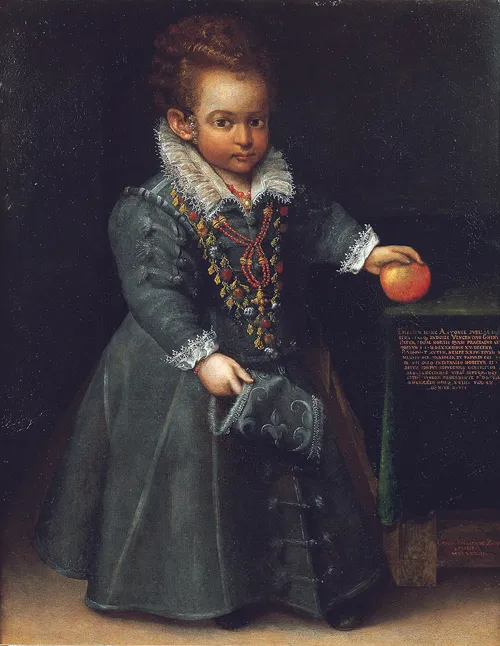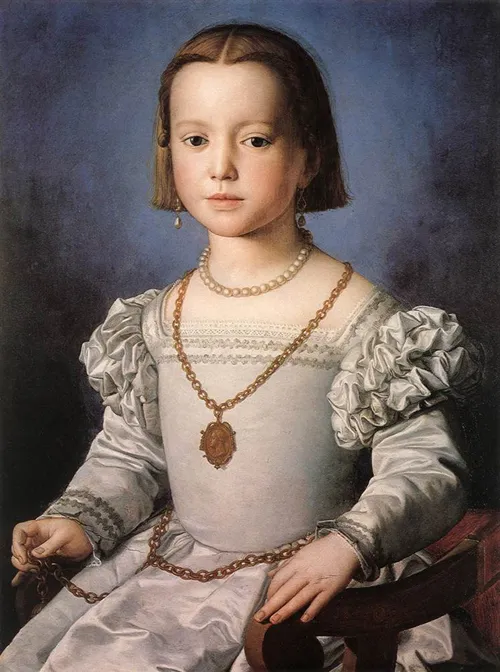![]()
1
IN THEIR IMAGE
In 1581, friends Lavinia Fontana and Scilla Ghini were each with child. Only two months further along in her pregnancy, Lavinia was first to give birth at 6:15 pm on January 2nd, naming Scilla godmother.1 Sadly, her daughter Laura did not live to see a full day. Two months later, Antonia Ghini was born but soon became infected with smallpox, succumbing to the disease before her second birthday. Her portrait, produced by Lavinia Fontana later that year, was painted of the girl posthumously (Fig. 11). A fact indicated only by the inscription that proclaims her father’s premonition of death and his description – as he was a medical doctor – of the way it came to pass. Close as the artist was to the child, Fontana was uniquely equipped to convey something of the child’s character in the painting. It is safe to assume that the artist shared in the mother’s loss, having cared for and watched her grow. In Antonia’s presence, she may have even enjoyed a vicarious glimmer of what may have been of her own lost infant. This portrait might then be understood as an expression of remembrance not just of Antonia, but through their connection, the memory of the artist’s daughter Laura as well.
Fig. 11. Lavinia Fontana. Antonia Ghini, 1583, Oil on Canvas, 87 × 72.5 cm. Rome, Private Collection.
Painted by Agnolo Bronzino, Bia de’ Medici’s portrait is widely believed to have been created posthumously, c. 1542 (Fig. 12).2 Cosimo de’ Medici commissioned this work himself in order to commemorate the short life of his illegitimate daughter who died at six years old. The doting father she leaves behind appears in profile on a charm around her neck.3 An intimate depiction, this portrait was likely intended for hanging within the inner chambers of the home for private viewing. That Bia was depicted as though alive, like Antonia, is notable. Like postmortem photography, portraits that are known to be painted posthumously tend to show the deceased, as though deceased. Unlike ‘posthumous commemorative or mortuary portraits’ that clearly depicted the deceased at rest, ‘posthumous mourning portraits’ can only be identified as such through the detection of discrete symbolic indicators.4 Indeed, the hidden nature of these cues makes them so hard to detect that, according to Jay Ruby, this genre was virtually unknown until art historian Phoebe Lloyd first identified the painting of a young boy as such in 1980.5
Fig. 12. Agnolo di Cosimo Tori, Known as Bronzino. Portrait of Bia de’ Medici, 1542–1555. Gallerie Degli Uffizi, Florence. By permission of the Ministry of Cultural Heritage and Activities.
The tendency for postmortem photography to depict the deceased at rest is not rooted in the constraints of the medium alone. As Ruby notes, photographers were presented with two established pictorial norms; that of ‘posthumous commemorative or mortuary portraits’ (which, given the expense, tended to be commissioned for the public viewing of wealthy individuals) and that of ‘posthumous mourning portraits’ (depicting the deceased as though once more living, intended for private viewing by the bereaved).6 Photographers settled into the aesthetic used in posthumous paintings typically intended for public viewing – depicting the deceased at rest – but the commemorative photographs they produced were increasingly destined for private viewing. Cheaper and thereby more accessible, postmortem photography came to replace the painted posthumous portraits they resembled – but not posthumous mourning portraits. That is, posthumous painted portraits that depicted the deceased as though once more alive, continued to be commissioned well into the mid eighteen-hundreds.7 Indeed, these were often painted from postmortem daguerreotypes.8 Bronzino did not have a daguerreotype of Bia at his disposal but many have suggested that he painted the portrait from her death mask.9 Was this mask produced for the sole purpose of recording the contours of her face – a painter’s aid? Or, might this intimate imprint have fulfilled an additional function as commemorative object?
Photographs are not the only means of rendering and capturing the likeness of an individual. Indeed, this practice is shown to enormously predate the invention of the medium. Unlike painting or drawing however, photographs feel less like an interpretation and more like an imprint.10 By virtue of the process that requires light to bounce off the sitter and back towards the lens, photography offers more than iconic likeness – photographs are also indexical. That is, they look like the individual pictured but also seem to have touched them, like a footprint or a death mask. Geoffrey Batchen notes that this additional quality contributes to photography’s ‘privileging’ over ‘other systems of representation, the camera does more than just see the world; it is also touched by it’.11 The objects or subjects figuring in photographic images appear to
have reached out and impressed themselves on the surface of the photograph, leaving their own visual imprint, as faithful to the contour of the original object as a death mask is to the newly departed.12
An umbilical cord seems to extend from the sitter to the image, nourishing the viewer and connecting the beholder in eternity to the individuals pictured.13 Thus, photographs collapse both the iconic and indexical functions of the painted portrait and the death mask that may have brought comfort to Cosimo de’ Medici following the death of his daughter.
Cameras have the capacity to produce detailed depictions of all that presents before the lens. Photographs can show things as they were, but that is all they can convey. Any more meaning – any more information – must be attributed to the photograph by a willing (or unwilling) beholder.14 Therefore, there is the time of exposure but there are also many other ‘times’ involved in the ‘meaning-making’ of a photograph.15 Photographs signify more than one moment. They are the culmination of several moments, intentions and associations. Evolving and adapting within the ever-changing present, they remain dynamic and relevant.16
At all times both evidence and embellishment, photographs are copies of the physical world, reproduced and understood through multiple lenses and filters. Seemingly rooted in – and demonstrating a direct return to – some originary moment, memory is often subjected to similar discourse. Memory and imagination are often perceived as being in opposition to one another, rather than being embraced for the inseparable duality they represent. As Emily Keightley and Michael Pickering note, this unambiguous designation relegates memory to ‘empirical tests of veracity’ while the imagination is deemed ‘necessarily suspect in its relation to memory’s adherence to some “real world” of the past’.17 Keightley and Pickering’s term ‘mnemonic imagination’ foregrounds the role of imagination in remembrance. What is recalled ‘of an earlier experience is rarely, if ever, that experience as a whole’. Thus, they suggest, we must ‘build imaginatively’, on what is recalled ‘and make connections across time, always with the imperative need of the present shaping what we bring back, and bring together, at any particular stage in time’.18
Photography is subject to a similar discourse of evidence versus manipulated artefact – the moment of ‘illumination’ so often overshadowing that of ‘identification’. Margaret Olin notes that ‘[a] photograph enjoys an unusually close relationship to its referent,’ and that this connection is frequently credited to photography’s ‘key moment … when the shutter opens, allows light into the dark chamber within, and gives lasting representation to whatever is in front of its lens’. This prevalent theory however, ‘ignores another, equally important moment: the moment of identification. Someone must identify photographic images…’. And unlike the moment of illumination, this moment ‘does not distinguish photography from other visual images, or even from encounters in the world at large…’. Importantly, when beholding photographs, ‘it is not just identification of a subject that is at stake but, often, identification with it.’19 Identification is successful if the beholder deems it so and familiarity with the subject need only be assumed. Thus, identification is the first step towards elaboration, no matter how slight.
Photography, like memory, is not a direct route back to the moment of exposure, it includes all the time in between and – importantly – the moment of beholding when the photograph is reconsidered in the present. A photograph becomes meaningful only at the moment when meaning is attributed by a viewer. The viewer lends the photograph life through recognition and then through imagination – imagining circumstances beyond the frame.20 Similarly, memory involves both a kind of recognition and then an elaboration. Photographs and memory allow us to revisit absent individuals. Naturally, these photographs – memories – are more heavily visited, replayed and elaborated when they become the only manner through which reunion is possible.
The most affordable – and thereby popular – photographic processes have not been direct one-to-one (the potential for multiple positive reprints making the negative imprint more appealing). Negative film-based photography – that now outdated and yet theoretically influential method – involves an incredibly murky in-between stage that is overlooked by the average consumer. But anyone who has fumbled in the dark to crack open, unravel and wind a canister for developing, remembers. For them, for me, photographs include this seemingly endless and sublimely precarious moment.21 The blind, wilful retrieval of latent trace.
The photographic process parallels the murky renegotiation of memory therefore not just conceptually (connected to an originary moment that is identified and elaborated in the present) but via the very mechanics of photographic film. Suspended in the gelatin emulsion, silver halide crystals are pure potential. Should they be exposed to light, a latent image forms in this spectral plane and remains there until the information is sought (if the skill is there to develop and derive what is available). Just as the latent image rests on the silver halide crystals, the impressions individuals make upon ot...


